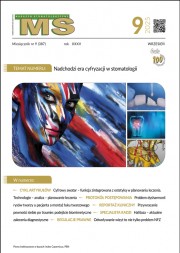Dostęp do tego artykułu jest płatny.
Zapraszamy do zakupu!
Po dokonaniu zakupu artykuł w postaci pliku PDF prześlemy bezpośrednio pod twój adres e-mail.
Radiodensitometric evaluation of optical density of enamel and dentine before and after bleaching in vitro
Chociaż wybielanie zębów staje się coraz powszechniejsze wśród pacjentów stomatologicznych, to doniesienia na temat wpływu tego zabiegu na struktury zęba są niejednoznaczne, a metody stosowane w ich ocenie są destrukcyjne dla tkanek i nie mogą być używane w warunkach przyżyciowych. Celem pracy była ocena gęstości optycznej szkliwa i zębiny zębów przed wybielaniem i po wybielaniu na cyfrowych zdjęciach rentgenowskich. Materiał stanowiło 65 plastrów zębowych grubości 1 mm poddanych wybielaniu preparatem zawierającym 35% nadtlenek wodoru (Bianco Supreme). Przed wybielaniem i po wybielaniu wykonywano zdjęcie rentgenowskie próbek w systemie radiografii cyfrowej Digora (Soredex), a następnie mierzono gęstość optyczną w wybranych regionach zainteresowania w obrębie szkliwa i zębiny. Stwierdzono, że gęstość optyczna twardych struktur zęba zmniejszyła się znamiennie po zastosowaniu preparatu wybielającego. Spadek gęstości optycznej zależał od rodzaju tkanki i był większy w przypadku zębiny niż szkliwa.
Ingrid Różyło-Kalinowska, Marcin Taras, T. Katarzyna Różyło
Although tooth whitening is becoming more common in dental patients, reports about the influence of this procedure on the structure of the tooth are not equivocal and the methods used are, in their opinion, destructive to the tissues and cannot be used in real life. The aim of the study was to evaluate the optical density of enamel and dentine of teeth before and after whitening, as seen on digital radiographs. The materials consisted of 65 dental plasters of 1 mm thickness with whitening using preparations containing 35% hydrogen peroxide (Bianco Supreme). Before and after whitening, X-ray pictures were made of samples using the Digora (Soredex) digital radiography system. Subsequently the optical density was measured in selected regions of interest in the enamel and dentine. It was found that the optical density of the hard structure of the tooth was significantly reduced after using the whitening agent. The reduction of the optical density depended on the type of tissue and was greater in the case of dentine than in that of enamel.













